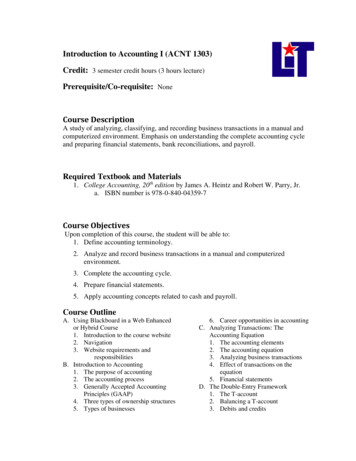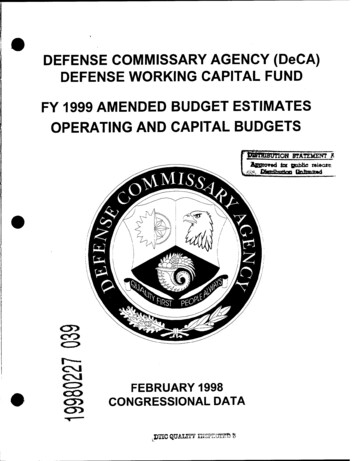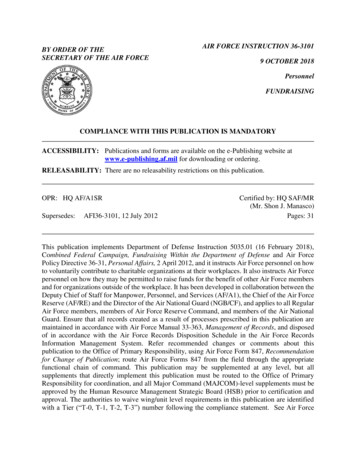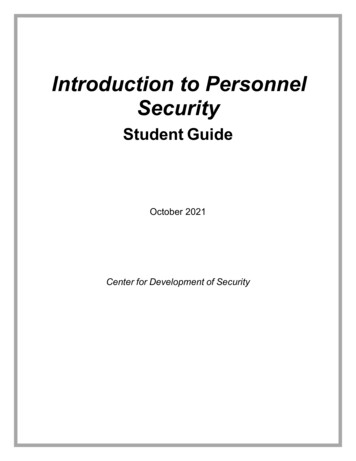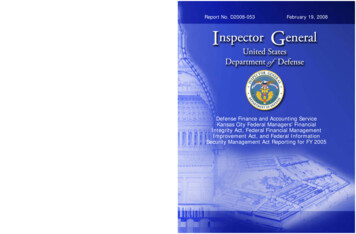
Transcription
Report No. D2008-053February 19, 2008Defense Finance and Accounting ServiceKansas City Federal Managers' FinancialIntegrity Act, Federal Financial ManagementImprovement Act, and Federal InformationSecurity Management Act Reporting for FY 2005
Additional CopiesTo obtain additional copies of this report, visit the Web site of the Department ofDefense Inspector General at http://www.dodig.mil/audit/reports or contact theSecondary Reports Distribution Unit at (703) 604-8937 (DSN 664-8937) or fax(703) 604-8932.Suggestions for Future AuditsTo suggest ideas for or to request future audits, contact the Office of the DeputyInspector General for Auditing at (703) 604-9142 (DSN 664-9142) or fax (703)604-8932. Ideas and requests can also be mailed to:ODIG-AUD (ATTN: Audit Suggestions)Department of Defense Inspector General400 Army Navy Drive (Room 801)Arlington, VA MCAnnual Statement of AssuranceDefense Finance and Accounting ServiceFederal Financial Management Improvement ActFederal Information Security Management ActFederal Managers’ Financial Integrity ActGovernment Accountability OfficeInformation TechnologyOffice of Management and BudgetUnited States Marine Corps
INSPECTOR GENERALDEPARTMENT OF DEFENSE400 ARMY NAVY DRIVEARLINGTON, VIRGINIA 22202-4704February 19, 2008MEMORANDUM FOR UNDER SECRETARY OF DEFENSE(COMPTROLLER)/CHIEF FINANCIAL OFFICERDIRECTOR, DEFENSE FINANCE AND ACCOUNTINGSERVICENAVAL INSPECTOR GENERALSUBJECT: Report on Defense Finance and Accounting Service Kansas City FederalManagers' Financial Intcgrity Act, Federal Financial ManagementImprovement Act, and Federal Information Security Management ActReporting for FY 2005 (Report No. D-2008-053)We are providing this report for review and comment. We considered commentsfrom the Defense Finance and Accounting Service when preparing the final report.DoD Directive 7650.3 requires that all recommendations be resolved promptly.The Defense Finance and Accounting Service comments were partially responsive. Werequest additional comments on Recommendations A.I., B.2., and C. Therefore, werequest that the Director, Defense Finance and Accounting Service provide comments byMarch 19,2008.If possible, please send management comments in electronic format (AdobeAcrobat file only) to AudDFS@dodig.mil. Copies of the management comments mustcontain the actual signature of the authorizing official. We cannot accept the / Signed /symbol in place of the actual signature. If you arrange to send classified commentselectronically, they must be sent over the SECRET Internet Protocol Router Network(SIPRNET).We appreciate the courtesies extended to the staff. Questions should be directedto Edward A. Blair at (216) 706-0074 ext. 226 or Ms. Cecelia M. Ball at (816) 926-8501ext. 222 (DSN 456-850 I). The team members are listed inside the back cover. SeeAppendix B for the report distribution.By direction of the Deputy Inspector General for Auditing:fWv t!,/J1CW»Patricia A. Marsh, CPAAssistant Inspector GeneralDefense Financial Auditing Service
Department of Defense Office of Inspector GeneralReport No. D-2008-053February 19, 2008(Project No. D2005-D000FC-0294.000)Defense Finance and Accounting Service Kansas City FederalManagers’ Financial Integrity Act, Federal FinancialManagement Improvement Act, and Federal InformationSecurity Management Act Reporting for FY 2005Executive SummaryWho Should Read This Report and Why? Defense Finance and Accounting Service(DFAS) Headquarters, Cleveland, and Kansas City personnel responsible for the internalcontrol program and Annual Statement of Assurance reporting; and Department of Navyand United States Marine Corps personnel responsible for financial management andreporting should read this report. This report contains recommendations that DFASKansas City should follow to ensure that effective internal controls are in place to assessand report on its Management Control Program. The United States Marine Corps relieson assurances made regarding the effectiveness of controls DFAS Kansas City uses toprepare the United States Marine Corps stand-alone financial statements. The UnitedStates Marine Corps financial statements are consolidated into the Department of Navyfinancial statements.Background. This report provides an assessment of the reliability of the DFAS KansasCity FY 2005 Annual Statement of Assurance report on internal control required by theFederal Managers’ Financial Integrity Act (FMFIA) and Federal Financial ManagementImprovement Act (FFMIA). In addition, this report provides an assessment of DFASFederal Information Security Management Act (FISMA) reporting on its securityprogram. DFAS Kansas City is responsible for reporting the United States Marine Corpsfinancial statement data to the Department of the Navy. This report discusses how DFASKansas City implemented policies and procedures governing internal controls overfinancial data.Results. DFAS Kansas City did not have adequate processes in place to determinewhether material internal control weaknesses existed and were included in the FMFIA,FFMIA, and FISMA annual reports as required. Specifically, DFAS Kansas City did nothave an adequate management control program (finding A), did not comply withfinancial management system control reporting requirements (finding B), and submittedincomplete information for Federal Information Security Management Act reporting(finding C). Without adequate processes in place, DFAS Kansas City and the UnitedStates Marine Corps cannot ensure an effective control environment for producingaccurate and timely financial information. DFAS Kansas City must address thesevulnerabilities as required by Federal and DoD criteria outlined in the report. See theFindings section of the report for the detailed recommendations.Management Comments and Audit Response.The Director, DFAS Kansas City nonconcurred with all recommendations. He includedin his comments that the Chief Information Officer, Defense Finance and AccountingService also nonconcurred with the recommendations. Although the Director, DFAS
Kansas City nonconcurred, we identified some corrective actions that we considerresponsive to the intent of the recommendations. These actions were responsive andfurther comments are not required. We revised and redirected other recommendations tothe Director, DFAS because comments were not responsive.We request that the Director, DFAS comment on the final report by March 19, 2008. Seethe Findings section of the report for a discussion of management comments and theManagement Comments section of the report for the complete text of the comments.ii
Table of ContentsExecutive SummaryiBackground1Objectives3FindingsA. Adequacy of Internal Control ProgramB. Financial Management System Controls ReportingC. FISMA Reporting41115AppendixesA. Scope and MethodologyPrior CoverageB. Report Distribution181820Management CommentsDirector, DFAS Kansas City23
BackgroundThe Defense Finance and Accounting Service (DFAS) Kansas City is responsiblefor reporting the United States Marine Corps (USMC) financial statement data tothe Department of the Navy. This financial statement data is ultimately includedin the DoD consolidated financial statements. USMC relies on DFAS KansasCity’s assurances regarding the controls used to prepare the USMC financialreports and ultimately its financial statements. The DFAS Kansas CityAccounting Business Line provides controls and functional managementoversight of accounting services and processes used to generate the USMCfinancial statements. Established controls should reasonably ensure that assetsare safeguarded. In addition, these controls should reasonably ensure thatobligations, revenues, and expenditures are accounted for and properly recordedto produce reliable financial reports. These disciplined financial and managementcontrols are essential in preventing potential fraud, waste, and abuse. DFASKansas City reports on its internal control structure in its Annual Statement ofAssurance (ASA).Management Control Reporting. All agency heads must evaluate and reportannually to the President and Congress on their management controls andfinancial systems used to protect the integrity of Federal programs. Thisreporting is required by the: Federal Managers’ Financial Integrity Act of 1982 (FMFIA), Federal Financial Management Improvement Act of 1996 (FFMIA),and Federal Information Security Management Act of 2002 (FISMA).FMFIA Reporting. In 1982, Congress passed the FMFIA,1 which requiresagencies to develop cost-effective internal accounting and administrative controls.These controls are intended to help ensure that an agency’s: obligations and costs are in compliance with applicable law; funds, property, and other assets are safeguarded against waste, loss,unauthorized use, or misappropriation; and revenues and expenditures applicable to agency operations areproperly recorded and accounted for.Section 2 of the FMFIA requires the head of each agency to evaluate annually theagency’s internal control and prepare an ASA indicating the effectiveness of itsinternal control. The agency head must include in its ASA any identified material1The key provisions of FMFIA were codified in section 3512 (c) and (d), title 31, United States Code.1
weaknesses in internal control as well as plans and schedules for correcting thoseweaknesses.Section 4 of the FMFIA requires that the head of each agency include a separatereport on whether the agency’s accounting system conforms to the principles,standards, and related requirements prescribed by the Comptroller General.FFMIA Reporting. The FFMIA is intended to advance Federal financialmanagement by ensuring that Federal financial management systems: can and do provide reliable, consistent disclosure of financial data; disclose financial data in a manner that is uniform across the FederalGovernment from year to year; and comply with applicable Federal accounting standards.The FFMIA is intended to provide the basis for ongoing use of reliable financialinformation in program management and in oversight by the President, Congress,and the public. Even though there are separate reporting requirements for FFMIA,the FMFIA requires that the FFMIA information be included in Section 4 of theFMFIA ASA.FISMA Reporting. FISMA provides the framework for securing the FederalGovernment’s information technology including both unclassified and nationalsecurity systems. These systems include financial and non-financial systems. Allagencies must implement the requirements of FISMA and report annually to theOffice of Management and Budget (OMB) and Congress on the effectiveness oftheir security programs based on OMB guidance and requirements. If the securityprograms do not fully comply with FISMA requirements, these weaknesses mustbe reported in the annual FMFIA ASA and FFMIA reports.OMB Guidance. OMB Circular A-123, “Management’s Responsibility forInternal Control,” revised June 21, 1995,2 provides guidance to Federal managerson improving the accountability and effectiveness of Federal programs andoperations by establishing, correcting, and reporting on internal control.OMB issued “Revised Implementation Guidance for the Federal FinancialManagement Improvement Act,” on January 4, 2001. This guidance lists thespecific requirements of FFMIA, as well as factors to consider in reviewingsystems for compliance. It also provides guidance to agency heads developingcorrective action plans to bring an agency into compliance with FFMIA.2OMB Circular A-123 was revised December 21, 2004; the revision was not in effect until FY 2006, butagencies were encouraged to implement it in FY 2005. The revision changed terminology from“management controls” to “internal control” and added Appendix A to specifically address assessing,documenting, and reporting on the effectiveness of internal control over financial reporting. Appendix Awas added to strengthen the previously identified internal control reporting requirements.2
In addition, OMB issued Memorandum M-05-15 “FY 2005 ReportingInstructions for the Federal Information Security Management Act and AgencyPrivacy Management,” on June 13, 2005. This memorandum providesinstructions for agency reporting under FISMA. The agency’s FISMAinformation is submitted to OMB.Ultimately, OMB uses the information to: help evaluate agency-specific and Government-wide securityperformance, develop its annual security report to Congress, assist in improving and maintaining adequate agency securityperformance, and develop the E-Government Scorecard as part of the President’sManagement Agenda.DoD Guidance. DoD Instruction 5010.40, “Management Control ProgramProcedures,” August 28, 1996,3 is the official document for DoD compliance withthe FMFIA and OMB Circular A-123. DoD Instruction 5010.40 sets forth theresponsibilities of the Under Secretary of Defense (Comptroller)/Chief FinancialOfficer with regard to implementing its program.To satisfy the reporting requirement of FMFIA, DoD, using information from theDoD Components, prepares an ASA to report on whether the agency’s internalcontrol is effective and achieving the intended objectives in accordance withestablished guidelines and standards. Compliance with FMFIA, FFMIA, andFISMA reporting should be used as an indicator that disciplined financial andmanagement controls are in place. Effective management controls are intended toprevent potential fraud, waste, and abuse.ObjectivesThe overall audit objective was to assess the internal controls in place forreporting USMC financial and management data as related to accountingfunctions performed by DFAS Kansas City. Specifically, we determined whetherthe processes for completing FY 2005 reports required by the FMFIA, FFMIA,and FISMA were adequate. See Appendix A for a discussion of the scope andmethodology.3Our review of internal controls was done under the auspices of DoD Directive 5010.38, “ManagementControl Program,” August 26, 1996, and DoD Instruction 5010.40, “Management Control ProgramProcedures,” August 28, 1996. DoD Instruction 5010.40, “Managers’ Internal Control Program,” wasreissued on January 4, 2006. DoD Directive 5010.38 has been incorporated into DoD Instruction5010.40 and DoD Directive 5010.38 has been cancelled.3
A. Adequacy of Internal ControlProgramDFAS Kansas City Accounting Business Line personnel did notadequately implement OMB, DoD, and DFAS guidance to comply withFMFIA requirements. Specifically, DFAS Kansas City AccountingBusiness Line personnel did not: complete required risk assessments for each functional area, properly identify management controls, determine whether all major functions were included in anassessable unit,4 and provide control testing documentation supporting the FMFIAASA report.FMFIA requirements were not adequately implemented because DFASKansas City Accounting Business Line personnel did not receiveappropriate oversight and training. In addition, they were not fully awareof their reporting responsibilities. As a result, the processes used did notmeet FMFIA requirements, and DFAS Kansas City cannot ensure thereliability of its FMFIA ASA.Risk AssessmentsDFAS Kansas City did not complete required risk assessments for each functionalarea. OMB Circular A-123, “Management Accountability and Control,” revisedJune 21, 1995; DoD Instruction 5010.40, “Management Control ProgramProcedures,” August 28, 1996; and DFAS Kansas City Standard OperatingProcedures, “Federal Managers’ Financial Integrity Act, Section 2 ManagementControl Program,” July 28, 2004, require risk assessments to determine afunctional area’s (assessable unit’s) vulnerability to waste, fraud, loss, abuse,mismanagement, and misappropriation. DFAS Kansas City Management ControlEvaluations identified risks as error reports, incomplete cycles, and poor customerservice. However, OMB A-123 states that risk assessments should address thepotential effect on the financial statements and the five financial statementassertions of: 4existencecompletenessvaluationAn assessable unit is a function or group of functions that require a manager to control resources within abusiness line or support service.4
rights and obligationspresentation and disclosure.Without DFAS Kansas City identifying areas of risk, they cannot design orinstitute controls to minimize that risk. DFAS Kansas City personnel were notproperly trained and were unaware of the requirements. DFAS Kansas Cityprovided FMFIA reporting requirements training in April 2006 to DFAS KansasCity personnel. In addition, in September 2006, the Office of Under SecretaryDefense (Comptroller)/Chief Financial Officer provided training on OMBCircular No. A-123, Appendix A. However, this training occurred after the 2006ASA was issued, and the training did not incorporate all requirements for FMFIAASA reporting. The training only addressed the financial reporting requirements,not the entire Management Control Program. We reviewed the FY 2006 DFASKansas City ASA and supporting information. We determined DFAS KansasCity did not implement significant changes to its risk assessment processes for FY2006.Internal ControlsDFAS Kansas City personnel did not properly identify internal controls becauseDFAS Kansas City identified performance measures in its Management ControlEvaluations. OMB Circular A-123 defines internal controls as the organization,policies, and procedures used to reasonably ensure that: resources are used consistent with the agency mission; programs and resources are protected from waste, fraud, andmismanagement; and reliable and timely information is obtained, maintained, reported, andused for decision making.DFAS Kansas City did not define their internal controls as required, but insteadidentified performance measures as internal controls. For example, FieldAccounting personnel stated that one of their controls was to use desktopprocedures and journal vouchers to ensure timely preparation and delivery of themonthly trial balance to Departmental Accounting. The reported internal controlsdid not indicate how those controls ensured the accuracy and reliability offinancial information, only that the trial balances were delivered timely. Uponsubsequent review of the FY 2006 DFAS Kansas City ASA and supportinginformation, we determined that DFAS Kansas City did not implement significantchanges to identify applicable Managers’ Internal Controls.5
Assessable UnitsDFAS Kansas City Accounting Business Line personnel did not determinewhether all major functions were included in an assessable unit. DFAS KansasCity standard operating procedures require that flowcharts be completed for majorfunctions and processes to identify internal controls and their locations. All majorfunctions and activities must be included in one or more assessable units.Assessable units should be linked to specific processes identified in theflowcharts.DFAS Kansas City Accounting Business Line personnel were unable to provideflowcharts or other documentation to identify internal controls and where thecontrols reside in DFAS processes as required by DFAS regulations. BecauseDFAS Kansas City could not provide this documentation and DFAS Kansas Citypersonnel were unclear as to their duties in regards to FMFIA, we have noassurance that all major functions were included in an assessable unit. Uponsubsequent review of the FY 2006 DFAS Kansas City ASA and supportinginformation, we determined that DFAS Kansas City did not implement significantchanges to ensure that all major functions were included in an assessable unit.Control Testing DocumentationDFAS Kansas City did not provide control testing documentation supporting itsFMFIA ASA. OMB Circular A-123 requires that documentation for internalcontrols and other significant events must be clear and readily available forexamination. In addition, DoD Instruction 5010.40 and DFAS Kansas Citystandard operating procedures require that appropriate documentation bemaintained. Specifically, DFAS Kansas City standard operating proceduresrequire that a file be maintained for supporting documentation and work papersassociated with each Management Control Evaluation completed. ManagementControl Evaluations are used to document the testing of these internal controls.We requested internal control documentation supporting DFAS Kansas CityManagement Control Evaluations. DFAS Kansas City could not provide thetesting documentation as required because they were not fully aware of theirreporting responsibilities. As a result, we could not verify the adequacy of theManager’s Annual Assessable Unit Certification Statement. Upon our subsequentreview of the FY 2006 DFAS Kansas City ASA and supporting information,DFAS Kansas City did not implement significant changes to maintain testingdocumentation supporting the ASA report.ConclusionThe Internal Control Program processes reviewed did not provide adequateinformation to ensure accurate reporting for compliance with FMFIA. DFASKansas City personnel did not understand their duties or follow prescribed6
procedures for FMFIA reporting. This was evidenced by the lack of riskassessments, improperly identified internal controls, the inability to determinewhether all major functions were identified and included in an assessable unit,and the lack of control testing documentation. Until DFAS Kansas City followsthe OMB, DoD, and DFAS policies and procedures, its FMFIA ASA cannot berelied upon to provide accurate information on the effectiveness of the internalcontrol environment. The ASA becomes more critical as the USMC movesforward in obtaining an audit opinion on their stand-alone financial statements.In addition, as DFAS Kansas City is scheduled to close as part of the BaseRealignment and Closure, the importance of identifying and ensuring that propercontrols are in place becomes more critical as functions move to other DFASlocations. For FY 2006, DFAS Kansas City did not implement significantchanges to its ASA preparation and reporting processes to assess risks, identifyapplicable Managers’ Internal Controls, ensure all major functions were includedin an assessable unit, and maintain testing documentation supporting the ASAreport.Management Comments on the Finding and Audit ResponseManagement Comments on Adequacy of Internal Control Program. TheDirector, DFAS Kansas City stated that the processes reviewed provided adequateinformation to ensure accurate reporting for compliance with the FYs 2005 and2006 ASAs. To improve the Section 2 reporting, DFAS Kansas City sought tostrengthen the internal management control program by providing training oninternal control activities and implementing a new Internal Control Unit inAugust 2006. DFAS Kansas City does not agree that its internal controlprocesses could not identify risk and could not design or institute controls tominimize risks, but does agree that reporting and documentation could have beenimproved.Audit Response. DFAS Kansas City did provide training in September 2006;however, the training did not apply to the time frame for this audit. The Director,DFAS Kansas City agreed that reporting and documentation could be improved;the available documentation did not provide evidence that DFAS Kansas Cityinternal control processes identified risks, designed controls, and establishedcontrols to minimize risks.Recommendations, Management Comments, and AuditResponseRevised and Redirected. As a result of management comments, we revised andredirected Recommendation A.1 to the Director, DFAS to provide trainingregarding internal control to personnel responsible for current and future MarineCorps Accounting Business Line functions.7
A.1. We recommend that the Director, Defense Finance and AccountingService provide training to current and future Defense Finance andAccounting Service personnel responsible for the Marine Corps AccountingBusiness Line to ensure compliance with Office of Management and Budgetand Defense Finance and Accounting Service policies. Specifically, thetraining should cover:a. adequate risk assessments,b. the associated internal controls to ensure reliability,c. measurable assessable units, andd. procedures for maintaining control testing documentation.Management Comments. The Director, DFAS Kansas City nonconcurred. TheDirector, DFAS Kansas City stated that risk assessments were completed as partof the Management Control Assessable Unit Matrix Evaluation Form,documented, and signed in accordance with DFAS 5010.38-R (May 2002). Headded that the risk criteria cited by the DoD Office of the Inspector Generalapplies to the organizations responsible for reporting Internal Controls overFinancial Reporting (OMB A-123 Appendix A) not DFAS Kansas City.Regarding the internal controls to ensure reliability, the Director, DFAS KansasCity stated that their review of Assessable Unit Matrixes for FYs 2005 and 2006found that 83% and 97% respectively did not use Performance ManagementIndicators as Key Controls. Performance Management Indicators were identifiedin addition to other controls in those Assessable Units noted by the DoD Office ofthe Inspector General. The Director, DFAS Kansas City agreed that managers areresponsible for assessing whether all of their major functions are included in therespective assessable units. Although flowcharts were not required by the DFAS5010.38-R (May 2002), DFAS Kansas City standard operating procedures didrequire flowcharts but personnel did not follow the procedures. The Director,DFAS Kansas City also agreed that DFAS Kansas City provided incomplete testdocumentation. He indicated that the documentation for FYs 2005 and 2006 wassufficient to support the FYs 2005 and 2006 ASAs. He also stated that DFASKansas City received positive feedback on its Fund Balance With Treasuryprocesses from the Naval Audit Service in 2006 and the Standard Accounting,Budgeting, and Reporting System received Joint Financial ManagementImprovement Program certification by an independent firm (July 2005).Audit Response. The Director, DFAS Kansas City comments were notresponsive. He did not address the recommendation, but first focused on riskassessment criteria. Because DFAS Kansas City supports financial reporting forthe USMC, it is important that DFAS provide training for personnel to ensure thatOMB A-123 requirements are achieved. Second, we reviewed the support forDFAS Kansas City’s percentages; we determined that 35 percent and 21 percentof the Assessable Unit matrixes for FYs 2005 and 2006, respectively, werePerformance Management Indicators (performance measures). Performancemeasures do not ensure the accuracy and reliability of financial information. In8
addition, DFAS Kansas City analysis included Assessable Units that were notwithin the scope of this audit. Third, because the Director, DFAS Kansas Cityagreed that standard operating procedures requiring flowcharts were not followed,the recommendation should be implemented. Finally, the Director, DFAS KansasCity agreed DFAS Kansas City did not provide all ASA test documentation. Inthe absence of complete documentation, we could not verify that the FYs 2005and 2006 ASAs were fully supported. As part of internal management controlprocedures, complete documentation must be maintained to support the ASA.The Director, DFAS Kansas City indicated that the Naval Audit Service and JointFinancial Management Improvement Program Certification testing reportsreinforced the DFAS Kansas City internal control environment to support anASA. However, the results from this testing is only part of the entire internalcontrol program and deficiencies were identified in both reports. The NavalAudit Service performed testing only on Fund Balance With Treasury. TheStandard Accounting, Budgeting, and Reporting System did not pass testing forJoint Financial Management Improvement Program Certification, completed byan independent firm. The independent firm’s report did not state that theStandard Accounting, Budgeting, and Reporting System is Joint FinancialManagement Improvement Program certified. According to the independentfirm’s report, the Standard Accounting, Budgeting, and Reporting System wastested for only 212 of the 331 Joint Financial Management Improvement Programrequirements. Of the 212 Joint Financial Management Improvement Programrequirements tested, the Standard Accounting, Budgeting, and Reporting Systemfailed to meet 56 of those requirements, 23 of which were critical requirementsfor certification. Over one third, or 115, requirements for feeder systems shouldalso be assessed. DFAS must test these feeder systems to know the extent of theirfinancial systems compliance to FFMIA to support USMC financial reporting.We request that the Director, DFAS review and comment on our recommendationto provide training to personnel responsible for current and future Marine CorpsAccounting Business Line functions to ensure compliance with OMB and DFASpolicies.A.2. We recommend the Director, DFAS Kansas City designateknowledgeable personnel to lead and monitor the Defense Finance andAccounting Service Kansas City Management Control Program.Management Comments. The Director, DFAS Kansas City nonconcurred. TheDirector, DFAS Kansas City stated that it has had, and continues to have,knowledgeable personnel to lead and monitor its Management Control Program.DFAS Kansas City established a three-person Management Control Team inAugust of 2006 to provide additional support and capabilities.Audit Response. Although the Director DFAS Kansas City nonconcurred, thecomments are responsive. The establishment of a Management Control Teamindicates that corrective actions have been implemented that would meet theintent of our recommendation and potentially correct the deficiency. No furthercomments are requested.9
A.3. We recommend the Director, DFAS Kansas City coordinate withDefense Finance and Accounting Serv
Defense Finance and Accounting Service Kansas City Federal Managers' Financial Integrity Act, Federal Financial Management Improvement Act, and Federal Information Security Management Act Reporting for FY 2005 Report No. D2008-053 February 19, 2008. Additional Copies To obtain additional copies of this report, visit the Web site of the .




